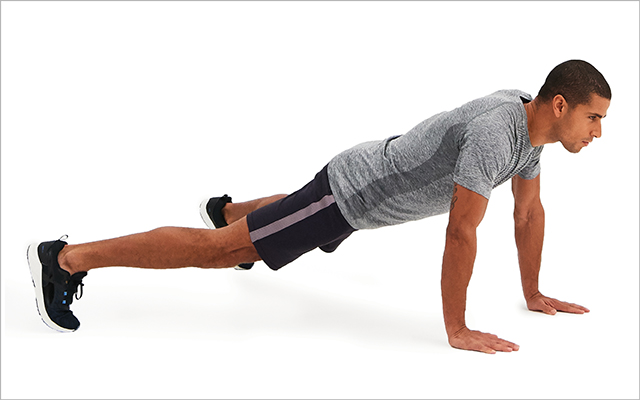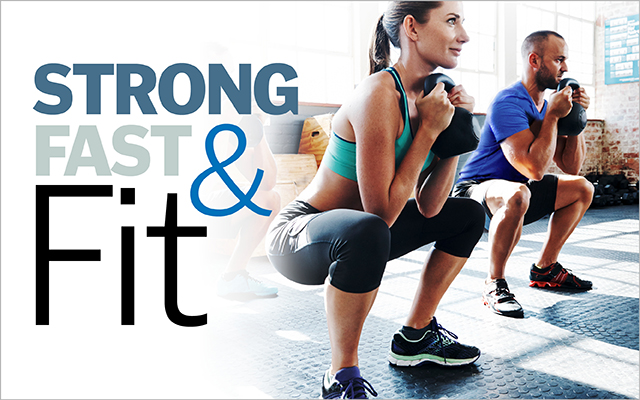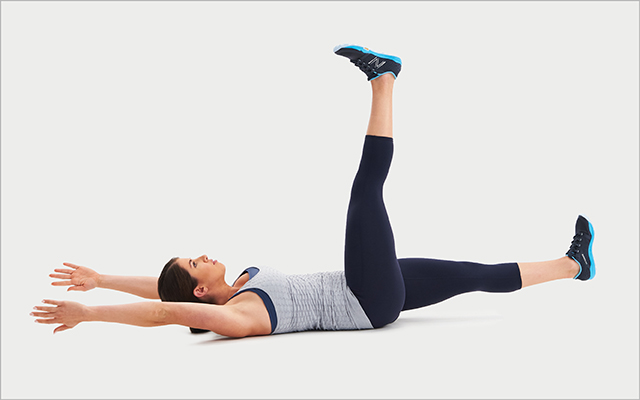Forget the “go hard or go home” hype: Your body is not a machine, and you can’t keep pushing yourself without ever taking a break.
“Improvements in performance and other fitness metrics are not linear,” says program designer Troy Jacobson, senior national director of Endurance Sports Training at Life Time. If you keep going harder and doing more, sooner or later you’ll hit a wall — or even injure yourself. The best way to avoid burnout is to back off right when you’ve achieved a mini-peak in your training.
If you’ve been following our training series for the last three months, you’ve earned the right to slow down, says Jacobson. While most gym-goers take time off at random, you’ve been working out long enough to warrant a month of workouts that are a little easier than what’s come before. (Just getting on board with the Strong, Fast, and Fit program? Get started at ELmag.com/strongfastfithome.)
This month, says Jacobson, “We focus more on cardiovascular fitness while maintaining earlier strength gains.” You can expect a cardio effect even in the strength circuits.
This recovery month is designed to set you up to achieve bigger gains in the next two months, as you move toward peak form in June.
Speaking of June: You might start thinking now about participating in a summer event that takes advantage of your burgeoning fitness. An active vacation, a long hike or bike ride, even an obstacle-course race or triathlon are all great options.
Month 4 Overview
For the next month, your workout schedule will look like this:
| Week | Monday | Tuesday | Wednesday | Thursday | Friday | Saturday | Sunday |
|
13 |
Rest | Cardio Workout A (Zones 2-3) |
Strength Workout A | Cardio Workout A (Zones 2-3) |
Strength Workout A | Cardio Workout A (Zones 2-3) |
Cardio Workout B (Zones 2-3) |
|
14 |
Rest | Cardio Workout C (Zones 3-4) |
Strength Workout A | Cardio Workout A (Zones 2-3) |
Cardio Workout A (Zones 2-3) |
Strength Workout B | Cardio Workout B (Zones 2-3) |
|
15 |
Rest | Strength Workout B; Cardio Workout A (Zones 2-3) |
Cardio Workout C (Zones 3-4) |
Cardio Workout A (Zones 2-3) |
Wildcard Day | Strength Workout B; Cardio Workout A (Zones 2-3) |
Cardio Workout B (Zones 2-4) |
|
16 |
Rest | Cardio Workout C (Zones 3-4) |
Strength Workout B | Wildcard | Rest | Strength Workout A | Cardio Workout B (Zones 2-4) |
Download Image of Month 4 Overview
- Make it work for you. Mix up your workout days to suit your schedule, but avoid back-to-back strength days without a rest, cardio, or wildcard day in between.
- Find your zone. Determine your work zones by calculating your anaerobic threshold (for a DIY method, visit “How to Calculate Your Anaerobic Threshold“) or taking an individualized metabolic test (available at many health clubs). You can also use the RPE (rate of perceived exertion) scale, a subjective effort scale consisting of five levels, as defined in the chart below.
- Wildcard day. This is an optional workout day. If you’re feeling strong and energetic, do a light-to-moderate 30- to 45-minute cardio workout. If you’re feeling fatigued, take an extra rest day.
- On rest days, rest. Recovery days are just as important as workout days, says Jacobson. Don’t skip them.
RPE Scale
| Zone | Percentage of Maximum Effort | How It Feels |
| 1 | 50%-60% | Very easy, possible to continue for long periods |
| 2 | 60%-70% | Easy, with light sweating |
| 3 | 70%-80% | Light muscular fatigue, moderate sweating |
| 4 | 80%-90% | Very heavy breathing, high muscular fatigue |
| 5 | 90%-100% | Maximum, all-out effort |
The Workouts
For both strength and conditioning workouts, perform three rounds of the two circuits. Rest 30 seconds between exercises in Strength Workout A, 20 seconds between exercises in Strength Workout B, and one minute between rounds in both workouts.
For instance, in Strength Workout A Circuit 1, perform exercise A for 30 seconds, then rest for 30 seconds; perform B for 30 seconds, then rest for 30 seconds; perform C for 30 seconds, then rest 30 seconds; perform 30 seconds of D, then rest for one minute. Repeat the cycle two more times before moving on to Circuit 2.
Do the same for both circuits in Strength Workout B, but rest for 20 seconds between exercises instead of 30 seconds.
Always perform as many good-form reps as possible in the time allotted.
Strength Workout A
| Circuit 1 | Circuit 2 |
| A. Burpee Sprawl: 30 seconds
B. Plyo Lateral Jump: 30 seconds C. Assisted Pull-Up: 30 seconds D. Prisoner Squat: 30 seconds |
A. Wide-Grip Pushup: 30 seconds
B. Burpee Sprawl: 30 seconds C. Hollow Hold With Rotation: 30 seconds D. Leg Lift: 30 seconds |
Strength Workout B
| Circuit 1 | Circuit 2 |
| A. Pushup: 30 seconds
B. Plyo Lateral Jump: 30 seconds C. Arm–Leg Raise: 30 seconds D. Burpee Sprawl: 30 seconds |
A. Dumbbell Shoulder Press: 30 seconds
B. Hollow Hold With Rotation: 30 seconds C. Assisted Pull-Up: 30 seconds D. Burpee Sprawl: 30 seconds |
Cardio Workout A
Perform a cardiovascular exercise you enjoy — running, brisk walking, cycling, swimming, rowing — for 30 to 40 minutes, at a steady, challenging but manageable pace (Zones 2 to 3).
Cardio Workout B
Perform a cardiovascular exercise you enjoy for 45 to 60 minutes, at a steady, challenging pace (Zones 2 to 4).
Cardio Workout C
Warm up for 10 minutes doing a cardiovascular exercise you enjoy, slowly elevating your intensity to Zones 3 to 4. Then, perform a 90-second sprint interval in Zones 4 to 5. Rest for one minute. Repeat this work–rest cycle a total of seven times. When finished, perform an easy cool-down for 10 minutes.
Month 4 Exercises
Burpee Sprawl
- Assume a shoulder-width, athletic stance.
- Keeping your lower back in its natural arch, bend at the hips and knees and place your hands on the floor.
- Jump your feet backward into the pushup position: feet at shoulder width, body straight from your head to your heels, and the balls of your feet on the floor.
- “Jump” your legs out wide then back together again.
- Jump your feet forward to a squat position.
- Drop your hips, flatten your back, stand upright, and jump upward.
Plyo Lateral Jump
- Assume an athletic stance: feet at shoulder width, back straight, gaze forward.
- Bend your knees, engaging your glutes and keeping your weight evenly distributed into your heels, and swing your arms behind you.
- Using your arms for momentum and balance, jump up and to the right as far and as high as possible.
- Land softly on the floor and repeat, this time jumping to your left. Alternate sides for 30 seconds.
Dumbbell Shoulder Press
- Assume an athletic stance — feet at shoulder width, back straight, gaze forward — holding two medium-heavy dumbbells at shoulder height.
- Slowly press the dumbbells to arm’s length overhead.
- Reverse the movement, lowering the dumbbells back to shoulder height under control.
Assisted Pull-Up
- Place a chair, box, or bench beneath a chin-up station, high enough that when you stand on the bench and grasp the bar, your arms are bent.
- Stand on the box and assume an underhand grip — palms facing you — on the bar. (If you can’t reach the bar comfortably at this point, get a taller bench.)
- Simultaneously jump upward and pull yourself up with your arms until your chin clears the top of the bar.
- Hold the top position for a one-count, then slowly lower yourself back down to the bench, bending your legs slightly until your arms extend fully.
Arm-Leg Raise
- Assume a wide-grip pushup position: feet and hands slightly wider than shoulder width and the balls of your feet on the floor. Lock your arms out and straighten your body, heels to the top of your head.
- Keeping your body straight, your head in a neutral position, and all four limbs straight, simultaneously lift your right arm and your left leg about 12 inches from the floor.
- Lower and repeat with your left arm and your right leg, and continue alternating sides for 30 seconds.
Prisoner Squat
- With your hands interlaced behind your head and your feet parallel and slightly wider than shoulder width, slowly bend your knees and hips, sitting back until the tops of your thighs are parallel to the floor, keeping your lower back in a natural arch throughout the movement.
- Reverse the move, slowly standing, and repeat.
- If the movement feels awkward, try it with your heels elevated on 5-pound plates.
Wide-Grip Pushup
- Assume a wide-grip pushup position: feet slightly wider than shoulder width, each hand on the floor about 6 inches outside shoulder width, arms locked out, and body straight from your heels to the top of your head.
- Keeping your body straight and your head in a neutral position, simultaneously bend your arms and retract your shoulder blades until your chest lightly touches the floor — or as far as possible without losing good form.
- Reverse the movement, pushing yourself back up to the starting position.
- Too tough? Perform the exercise with your hands elevated on a box, table, or bench.
Leg Lift
- Lie on your back on a mat and press your lower back firmly into the floor, keeping it there for the duration of the movement.
- Lift your head slightly off the floor and extend your arms overhead, keeping your upper arms close to your ears.
- Keeping your knees extended and your feet flexed, raise your legs off the floor as high as you can.
- On a slow exhale, slowly lower your right leg toward the floor until your heel taps the floor.
- Return to the starting position and alternate legs for the duration of the set.
Hollow Hold With Rotation
- Lie on your back, knees pulled up toward your chest.
- Press your lower back into the floor and lift your head and upper back a few inches, like you’re doing a crunch.
- Extend your arms overhead and your legs outward, heels and hands hovering about 6 inches from the floor.
- Keeping your legs raised off the floor, slowly twist at the waist so your legs move slightly to the right, your arms slightly to the left.
- Reverse the movement and continue at a controlled pace for 30 seconds.




This Post Has 0 Comments